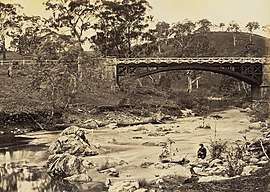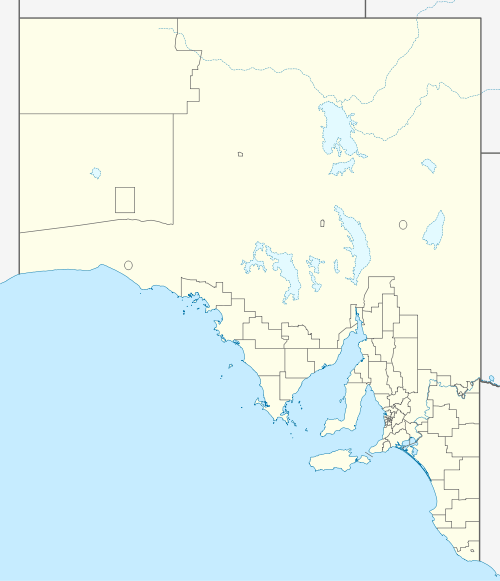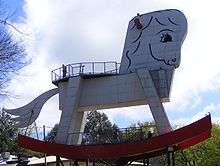Gumeracha, South Australia
Gumeracha (/ˌɡʌməˈrækə/ GUM-ə-RAK-ə) is a town in the Adelaide Hills, South Australia, located on the Adelaide-Mannum Road. It is located in the Adelaide Hills Council local government area on the south bank of the upper River Torrens. At the 2006 census, Gumeracha had a population of 731.[3]
| Gumeracha South Australia | |||||||||||||||
|---|---|---|---|---|---|---|---|---|---|---|---|---|---|---|---|
 Gumeracha Bridge circa 1869. | |||||||||||||||
 Gumeracha Location in South Australia | |||||||||||||||
| Coordinates | 34°49′37″S 138°53′00″E[1] | ||||||||||||||
| Population |
| ||||||||||||||
| Established | 1839 | ||||||||||||||
| Postcode(s) | 5233 | ||||||||||||||
| Elevation | 322 m (1,056 ft)[1] | ||||||||||||||
| Location | 37 km (23 mi) from Adelaide | ||||||||||||||
| LGA(s) | Adelaide Hills Council | ||||||||||||||
| State electorate(s) | Morialta | ||||||||||||||
| Federal Division(s) | Mayo | ||||||||||||||
| |||||||||||||||
| |||||||||||||||
| Footnotes | Adjoining localities [1] | ||||||||||||||
The region relies heavily on grazing, dairying, grape growing, orchards and market gardening.
History
Gumeracha[5] is one of South Australia's oldest settled areas. The first Europeans to explore and traverse through the district were Dr George Imlay and John Hill on 24 January 1838.[6] In 1839, the South Australia Company took up a parcel of land, on which the settlements of Gumeracha, Kenton Valley and Forreston developed. The company established a district headquarters and opened it up for sheep grazing.
In 1839, William Beavis Randell built his home, Tinmath, at Kenton Park and built a flour mill in the 1840s.[7] The estate housed his large family, his workforce and their families. In 1846, Randell donated land and funds for a church, and the Salem Baptist Church was built - the oldest Baptist church still in use in South Australia. The surrounding area, meanwhile, had become an agricultural centre, and the Gumeracha Farmers' Society held annual shows.
In 1853 the District Council of Talunga was established to administer the Hundred of Talunga including in large part the early Adelaide Hills pioneering community that would become Gumeracha. In 1855, Randell allocated land for a township and by 1860 the town was laid out.[8] Commercial businesses sprang up on the main street (Albert Street), and many fine buildings were erected, including the Post Office, Police Station & Court House (1864), Institute Hall, Town Hall (1909), a butter factory (1889), a school, a hospital, a coach-house, hotels, churches and business houses.[9] Most of the buildings in use at this time still stand today. William Beavis Randell's son, William Richard Randell, would build the first Murray River paddlesteamer in Gumeracha in 1852.
In 1935, the District Council of Gumeracha replaced Talunga council to administer a broader area around the town, centred at Gumeracha, the main point of population in that part of the Adelaide Hills.
Geography
Gumeracha is located between Inglewood and Birdwood along the Adelaide-Mannum Road, and north of Lobethal along the Gumeracha-Lobethal Road.
At the ABS 2001 census, Gumeracha had a population of 599 people living in 266 dwellings.
Facilities

Gumeracha is the regional centre for the area. It contains a primary school, hospital, community centre, sports Adelaide Hills Council (the main office is at Woodside). There is also a golf course in Kenton Valley south of the town.
Several wineries, including Guthrie Wines, Unico Zelo and Talunga Premium Wines, operate in Gumeracha and in nearby areas.
The most notable attraction of Gumeracha is the "biggest rocking horse in the world" - standing at 18.3 metres (60.0 ft) (approximately the height of a six-storey building), it is just east of the town on Main Road and serves to advertise the toy factory and wildlife park.
Gumeracha is also home to Applewood Distillery, Australia's highest altitude distillery, specialising in Gin and Amaro showcasing native Australian botanicals like finger limes and strawberry gum.
Transport
The area is not serviced by Adelaide public transport. A coach is operated from Tea Tree Plaza Interchange to Gumeracha and Mount Pleasant by LinkSA.[10]
References
- "Search results for 'Gumeracha, LOCB' with the following datasets selected - 'Suburbs and localities', 'Counties', 'Hundreds', 'Local Government Areas', 'SA Government Regions' and 'Gazetteer'". Location SA Map Viewer. South Australian Government. Retrieved 26 December 2018.
- Australian Bureau of Statistics (31 October 2012). "Gumeracha (State Suburb)". 2011 Census QuickStats. Retrieved 3 February 2016.

- Australian Bureau of Statistics (25 October 2007). "Gumeracha (L) (Urban Centre/Locality)". 2006 Census QuickStats. Retrieved 30 July 2011.
- "Monthly climate statistics: Summary statistics MOUNT CRAWFORD AWS (nearest weather station)". Commonwealth of Australia , Bureau of Meteorology. Retrieved 26 December 2018.
- Adelaide Hills Council - Historical Town Information Archived 25 June 2006 at the Wayback Machine Accessed 16 June 2006.
- The Australian, 27 March 1838, p.3.
- Adelaide Hills Online - Gumeracha Accessed 16 June 2006.
- "Placename Details: Gumeracha". Property Location Browser. Government of South Australia. 17 January 2014. SA0018523. Retrieved 17 November 2017.
Aboriginal name "Umeracha" taken from a nearby waterhole on the River Torrens. Originally a private subdivision of Sections 6057/8 & 6048. Town laid out in 1860 on land belonging to W B Randall. Captain Randall M.P. informed H.C. Talbot that his father built his home near a fine waterhole on the River Torrens, thought to have been called Umeracha by local Aboriginals. Boundaries created in October 2001 for the long established name.
- "Gumeracha Community Website". Archived from the original on 19 July 2006. Retrieved 16 June 2006.
- "Mount Pleasant to Tea Tree Plaza" (PDF). Archived from the original (PDF) on 6 July 2011. Retrieved 31 January 2010.